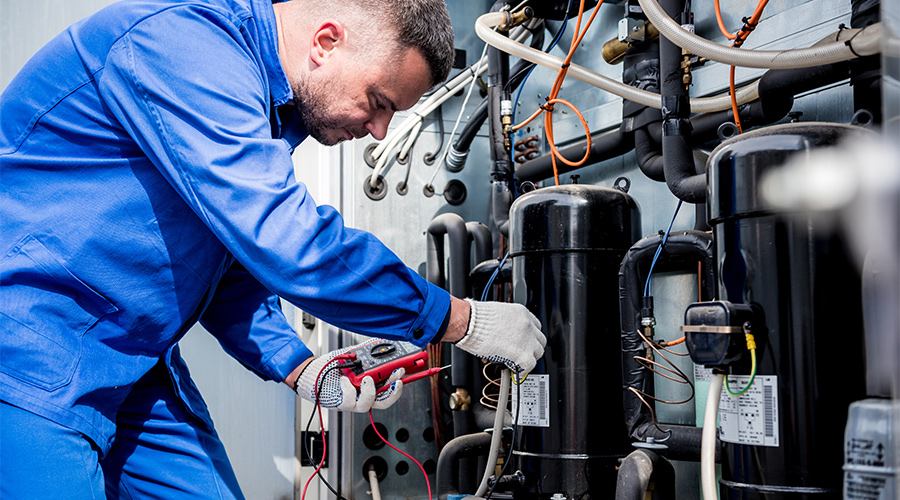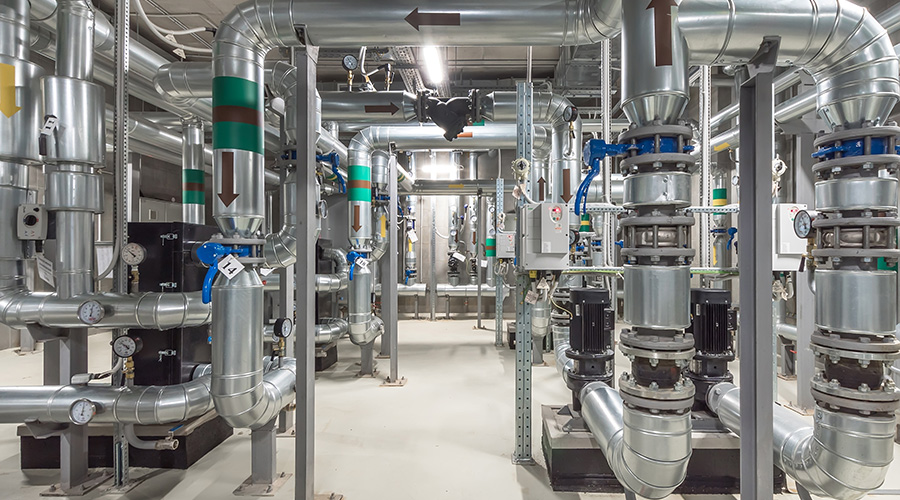Keeping Motors Running
Proper specification and post-installation maintenance combine to help managers control facilities’ energy use
From the early days of electricity as a viable form of energy, electric motors have consisted of a significant portion of the electrical load. Today, electric motors exist in almost every institutional and commercial facility.
And with the ever-growing pressure to cut energy use to lower costs, maintenance and engineering managers must examine the role of motors in overall facility energy efficiency. Simply installing energy-efficient motors is not enough because an energy-efficient motor can cost 25-30 percent more than a regular motor. Managers will only be able to achieve real, long-term savings by specifying the right motor for the application and devoting resources to motor testing and maintenance.
A Closer Look
Electric motors fall into two main groups based on input power. They can be powered by direct current (DC) or alternating current (AC).
DC motors usually are used for controls and other specialized applications. Most motors are powered either by three-phase or single-phase AC, which can be either synchronous and induction.
Synchronous motors run at a constant speed that is identical to the incoming power frequency. They are more complicated and more expensive to build and so tend to be used only in specialized applications where one exact speed is critical.
By contrast, induction motors are more common and tend to be the workhorses in facilities. These motors run more slowly than synchronous motors. In other words, the speed at full-load conditions is slightly lower than at no load. Since these motors are relatively inexpensive to build, they are the predominant type in most general applications.
The Role of Energy
Electric motors consume a significant portion of the world's energy today. It is estimated that 30-40 percent of all fossil fuel burned globally is used in generating electricity. Moreover, electric motors use about 60 percent of the electricity in the United States. That is why improving motor efficiency can have a significant impact in reducing electrical consumption.
Since the overwhelming majority of motors are three-phase motors ranging from 1-200 horsepower (hp), the latest energy policy targets improving the efficiency of motors in this range. Recognizing the importance of motor efficiency, the 1992 Energy Policy Act (EPACT) required motor manufacturers of general-purpose motors to comply with minimum requirements.
EPACT spelled out minimum efficiency levels for three-phase motors of 1-200 hp used for general-purpose applications. The reason for this is the energy cost to operate these motors in the U.S. is estimated at $30 billion per year, which implies that if the efficiency of these motors is increased by one percent, it results in $300 million saving annually.
Improving Reliability
The key for efficiency improvement is reducing motor losses. Motors basically have four different types of losses — copper, core, stray and mechanical.
Copper losses result from the resistive losses of the motor’s stator and rotors windings. Using larger-size wires for the stator and rotor winding can reduce these losses.
Core losses arise from magnetizing energy needed for the stack of motor laminations. Therefore, using better alloys for the core can lower these losses.
Stray losses are due to magnetic energy that is not contained in the core and, as a result, does not produce any useful energy. Managers can reduce these and windage losses through better design and optimizing of the air gaps, as well as through the shape of the rotor.
Finally, mechanical losses are due to friction and air resistance losses due to the coolant fan or rotor itself.
Another important aspect about these losses are the fact that core and mechanical losses are constant, regardless of load, while copper and stray losses vary with motor load. Since the first two losses are constant, motor efficiency is the highest at its full load conditions.
In order to improve the efficiency of motors, manufacturers can accomplish this by using a larger gauge wire for the stator and rotor windings, seeking better magnetic alloys for core, improving the design to reduce air gaps and mechanical friction.
Operational Efficiency
It should be evident that motor design and manufacturing has a significant role in its efficiency. By the same token, it is also important that maintenance and engineering managers pay close attention to the following operational factors:
Size. Managers need to select the properly a size motor for the load it will serve. In many applications in institutional and commercial facilities, managers have installed motors that are much larger than needed. An oversized motor not only means a higher installation cost. It also means that the motor will be running at a lower efficiency than at full load. Moreover, it will lower the system’s power factor, which increases system line losses.
Class. When choosing new equipment, managers need to specify the appropriate motor class. Motors are divided in four classifications, — A, B, C and D. The A class has the lowest starting torque but the highest running efficiency. These characteristics are reversed for D-class motors. The char-acteristics of the other two classes run between A and D. So if the starting torque is not a constraint, managers can specify an A-class motor for obtaining the highest operating efficiency. If an A-class motor does not give adequate torque, move to B or C, and finally to class D for applications that require only intermittent loads.
Line voltage. A motor's line voltage can play an important role in its efficiency. If the voltage is lower in order to meet the mechanical load, the motor will draw too much higher current, resulting in higher motor losses and a higher winding temperature. These conditions will shorten the useful life of the motor.
Maintenance. Devoting resources to motor testing and maintenance includes equipping front-line technicians with the tools and technology to troubleshoot po-tentially large motor problems. These tools commonly include digital voltometers, digital multimeters, time domain reflectometer, tone generators and wiremap testers. Managers also must ensure that technicians have the training to use these tools efficiently in order to diagnose small problems before they become major headaches.
Focus on Voltage
Even if managers select a high-efficiency motor that is properly sized for the load, it can have high losses, due to voltage unbalances in the electric supply. Voltage unbalance is the difference between the highest line-to-line voltage and the lowest line-to-line voltage divided by the average of the three voltages.
Even a small voltage unbalance impacts the motor efficiency significantly. The underlying reason for this phenomenon is the high level of current unbalance caused by even a small voltage unbalance. For instance, the current unbalance can be six to ten times higher and the temperature rise can be twice the square of the voltage unbalance. Also, even a few percentages points of voltage unbalance causes torques pulsation, increased vibration, and temperature elevation that leads to overheating.
For example, if the system voltage unbalance is 3 percent, then the current unbalance can be as high as 30 percent, and the temperature rise can be 2 x (3 x 3), or 18 percent. Such a temperature rise will shorten the life of a motor by 75 percent. Moreover, the motor's efficiency can drop by roughly 1.5 percent.
To examine these higher operating costs, assume that the motor in question is 150 hp and operates 7,500 hours annually and that the cost of electricity is 5 cents per kilowatt-hour. The additional cost per year resulting from these higher losses will be 150 x 0.746 x 7,500 x .015 x 0.05, or about $630 — in other words, more than one-third of the cost of the motor.
Another factor than can lower motor efficiency is harmonics in the power system. Some odd harmonics are positive, while others are negative. Negative harmonics do not generate torque opposite to the main motor torque. This not only lowers the net motor torque but will result in increased motor temperature, which lowers its useful life.
Energy-efficient motors by definition have smaller losses, including less heat generation. These motors run at lower temperatures, which results in a longer useful life for the motor.
Finally, the primary factors that determine the useful life of electric motors are the speed and torque. If a motor is running fast, it will experience a higher level of wear and tear that naturally shortens its life.
Similarly, when the torque requirement is increased, the motor current increases proportionately, results in higher current density and the erosion of motor brushes and commutators. The cumulative effect of these factors lowers the useful life of the motor.
Related Topics:











